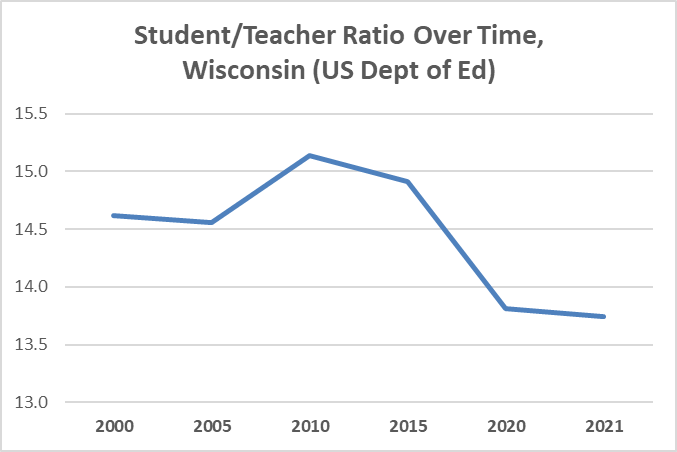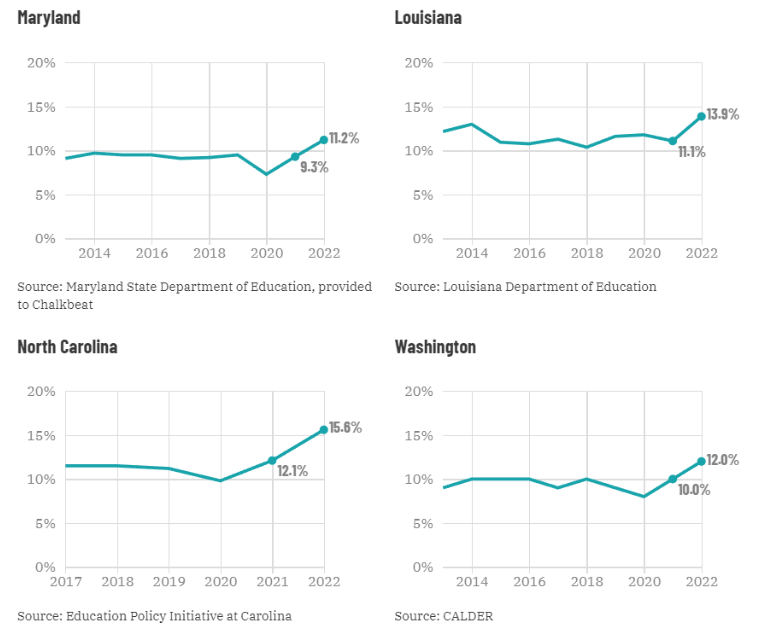Recently, Wisconsin’s Department of Public Instruction released a report on the teacher shortage in the state. The report claims that nearly 40% of teachers leave the profession within the first five years, and blames declines in teacher compensation over the past decade for the shift. While the problems identified in the report are legitimate, the causes and solutions offered are more representative of traditional liberal talking points than an honest effort to make improvements for the teaching workforce in the state. In this explainer, we identify a number of issues with DPI’s report.
How Severe is the Shortage, Really?
If teacher retention is a truly impactful problem, one would expect that schools in Wisconsin would be seeing larger and larger class sizes as districts are unable to fill teaching positions. But this is far from true: indeed, over the past decade, Wisconsin has actually seen student/teacher ratios decline. The table below reproduces data from the National Digest of Education Statistics from the United States Department of Education for student/teacher ratios since 2000. Note that the time gap for the last year is smaller than the rest–I wanted to include the most recent data. In 2000, Wisconsin averaged about 14.6 students per teacher. By 2021, this number had dropped by nearly a full student to 13.7. The reason for this is likely that Wisconsin has seen a dramatic decline in student enrollment in public schools over the past twenty years. While it is likely true that teaching positions have fewer applicants and some positions may be hard to fill, this data leads one to question how severe the problem actually is.
Figure 1. Student Teacher Ratios
Consistent with National Patterns
Despite attempts to blame Act 10 for the decline in teacher retention, in reality this is a problem around the county. Indeed, based on the numbers reported by DPI, Wisconsin may actually be better than average. A 2018 study estimated that 44% of teachers nationwide leave the profession within five years And this data was pre-COVID–there is extensive evidence that turnover has increased since then. To illustrate this, consider a recent Chalkbeat analysis looked at teachers leaving the profession across four states. Each of these states saw an annual turnover rate of more than 10% during the 2022 school year. A figure from that report is reproduced below.
Figure 2. Annual Teacher Turnover in Four States (Chalkbeat)

Even using the lower number observed in each state in 2021 and adding them up over five years, each of these states would see over 50% turnover in that time frame. Even more surprising, this analysis is not limited to the younger teachers that are the focus in Wisconsin. It is important to note that, at least in some of these states, teachers may have left for another school system. Nonetheless, a profession experiencing over 10 percent turnover annually has a huge problem—and it does mean that it’s not specific to issues in Wisconsin.
Much of the Compensation Decline is in Fringe Benefits
While there were modest declines in salary for teachers in the aftermath of Act 10, the largest decrease in total compensation comes from changes in fringe benefits. This is entirely sensible—as Act 10 mandated that teachers (and other public employees) make contributions to their healthcare and retirement accounts much like those of us in the private sector. A 2016 study from WILL examined the impact of Act 10 on salary and benefits. Controlling for other factors, we found that Act 10 reduced pay by about $141 annually, but benefits by about $634.
While ordinarily I wouldn’t cite an 8-year old study, this was actually the proper time frame for a look back in this instance—far too many years and other factors have intervened at this point to still blame Act 10 for changes. But the bottom line is that it is reasonable to expect teachers to contribute to their retirement, and going back the other way would be simply untenable for districts.
Repeats False Claims about Not Funding Public Schools
In a press release about the report, Superintendent Underly stated, “Solving this challenge starts with upholding the state’s responsibility of funding our public schools. We have the resources, and we owe it to our kids to do more.” As has often been the case lately with arguments for more school funding, the choice of the year 2010 as the baseline for arguing for more school funding is strategic, as this was a high watermark for school funding in the state.
The Figure below shows “all-in” student funding across Wisconsin from 2004 to 2022 including state, local, and federal money. The highest spending prior to this year was 2010—when an inflation-adjusted $16,637 was spent on average per student. There was decline after that year, but that came along with significant savings to the district from Act 10 that make it reasonable ot expect districts to do with less money. But perhaps more importantly, by 2022, Wisconsin has actually surpassed the high watermark of 2010 spending. Underly’s statement is false, and teachers should ask where all this money is going rather than into their bank accounts.
Figure 3. Revenue Per Student Over Time, Wisconsin

Ignoring the Role of School Discipline
When teachers don’t feel supported in the classroom, their job becomes immensely more difficult. Recent years have seen a move away from traditional discipline in the classroom to so-called “Restorative Justice” in education that lead to students avoiding punishment for misbehavior. WILL research has shown that this “soft discipline” is a negative for other students in the school, producing disruptive environments where learning cannot occur. This is doubly negative for teachers, tasked with creating an environment conducive to learning while feeling unsupported—or even endangered—by administrators who refuse to act on disciplining disruptive children. A recent survey by the NEA found that nearly half of teachers have considered resigning over school safety and climate. Addressing safety issues may not be woke, but is key to retaining educators.
Conclusions
None of this is to dismiss concerns about teacher retention in Wisconsin. WILL and other groups in the state have supported reforms like alternative licensure options that would help to increase the number of people entering the field. But we must move beyond traditional talking points that blame a lack of education spending for the workforce crisis.